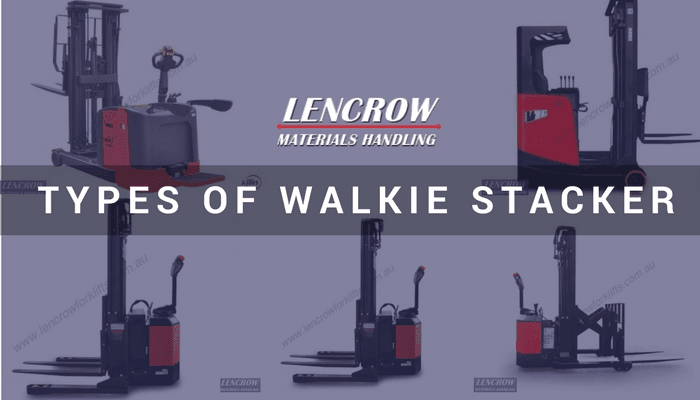Ross Grassick
Forklift Types
Walkie Stacker Types, Application & Advantages

A walkie stacker is also known as a pedestrian walk-behind stacker. It is a walk behind pallet truck with an attached mast for lifting pallets to heights. Walkie stackers come in diverse types for varied applications. So, let’s understand the different types of walkie stackers and their applications.
Walkie stackers are available in two main versions and they are manual and electric-powered. Where forklifts are not required, walkie stackers can be used for transporting and lifting pallets – for instance, in small warehouses, storerooms and in specialised warehousing sections. Walkie stackers are ideal for small capacity items that are transported around a warehouse for less than five hours each day. It is recommended that they should be used only on concreted flat floors and as they have small wheels, they are more suitable for indoor use; however, they can be ordered from the factory with special requirements like bigger wheels.
Types Of Walkie Stacker & Their Use :
The major distinctive feature between different walkie stackers is how they distribute their load with either straddle legs, counter balance weight or front legs.
1. Standard Walkie Stacker
Standard walkie stackers make use of legs that sit below the forks to assign load weight. This also facilitates them to lift and manage two pallets at the same time, which makes them perfect for applications that need both stacking of pallets and transportation. As compared to the other types of walkie stackers, standard walkie stacker provides the smallest turning circle. However, standard walkie stackers are able to lift only bottomless pallets or bottomless containers – this is because their legs sit below the forks. They are specifically made for mid-level racking applications and their minimum lifting heights commence from 1,845mm.
2. Ride on Walkie Stacker
Ride on walkie stackers is identical to standard walkie stackers in design; however, they have a platform and special controls to facilitate operators to ride on the walkie stacker. To operate a ride on walkie stackers, the driver needs a forklift license whereas walk behind units does not need any license. Minimum lifting heights commence from 2000mm and can extend up to 6110mm. To get more information regarding this type, you may also refer #1 (above) Standard walkie stackers.
3. Walkie Straddle Stacker
Walkie straddle stackers are the most popular type of walkie stacker to be seen here, in Australia. To allocate load weight, they make use of straddle legs. The legs facilitate walkie stackers to straddle a pallet so that the stacker can go up nearer to a pallet without needing much space. They are usually used for low to mid-level chosen racking applications like customer zone racking areas, small warehouses and storerooms. When floor stacking is employed, the straddle legs also facilitate closer pallet stacking. Racking should be set up in a way that can facilitate the straddled legs to steer around or below the racking bottom beam supports. Minimum lifting heights commence from 3300mm and can extend up to 5000mm.
4. Walkie Reach Stacker
After walkie straddle stackers, walkie reach stackers are widely used here, in Australia. They have an identical design that matches to straddle stacker; however, they are equipped with a pantographic scissor mast. That means the mast is able to manoeuvre loads forward, away from the stacker’s body. They are most frequently used in applications such as loading trucks, utility vehicles and trailers. Just like straddle stackers, they can also be used for general mid-level racking applications. Minimum lifting heights commence from 2000mm and can extend up to 6460mm.
5. Counter Balance Walkie Stacker
Counter balance walkie stackers use counter balance weight to allocate loads. This facilitates them to operate in narrow aisles than the more widely used straddle stacker as they do not have straddling legs outside of the unit’s body. Different from standard walkie stackers (with front legs) counter balance walkie stackers can lift standard pallets. Due to the counter balance weight, counter balance walkie stackers have the longest total length, which necessitates a bigger turning circle when compared to other types of stackers. The counter-balance walkie stacker has a different type of lifting mast and their minimum lifting heights commence from 2000mm and can extend up to 6000mm.
Manual Walkie Stackers
Manual walkie stackers are not recommended for handling pallets in racking as they have very restricted lifting heights and operate very slowly. Thus, they are only suggested for general lifting with very low volume of load.
Walkie Stackers’ Major Advantages
- One of the major advantages is it does not release smokes or exhaust pollution and makes no noise, which makes them perfect for indoor material handling.
- Thanks to their smaller size, operators have better visibility when handling loads.
- Walkie reach stackers are perfect for handling pallets in storerooms and in specialised warehousing sections like customer assigned storage spaces.
- They are highly manoeuvrable so they are able to work in compact spaces and can aid in expanding warehouse capacity.
- When compared to Diesel and LPG/Petrol forklifts, electric-powered equipment has lower operating costs on an ongoing basis.
- Unless walkie stackers are a ride on, operators do not need a forklift license to operate. Nevertheless, operators should be aware of safety practices and all the controls as well as acquire permission from their company to operate it.
- They generate lesser carbon emissions because they require lower energy.
- When compared to other materials handling equipment, walkie stackers have the lowest upfront cost.
